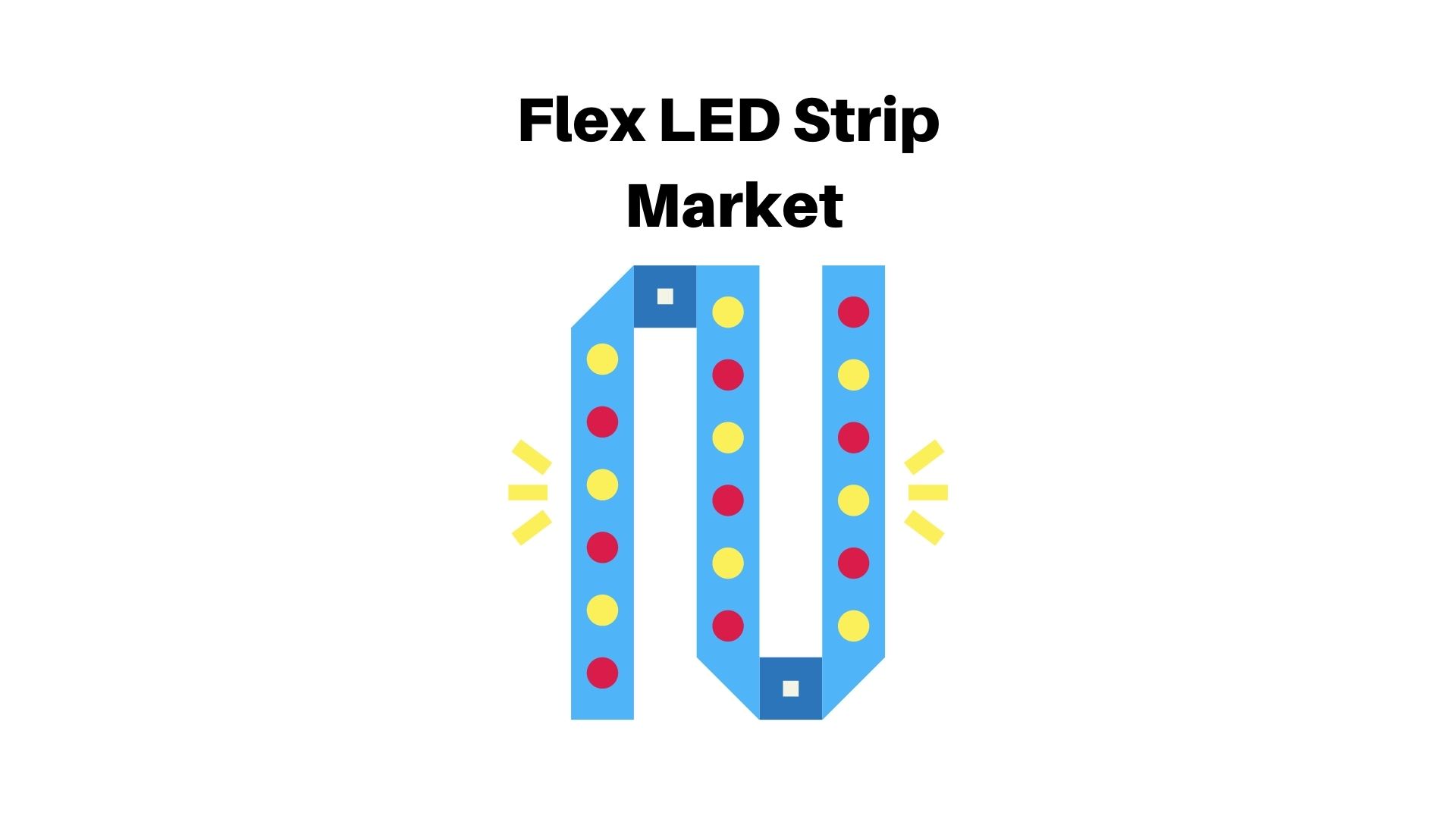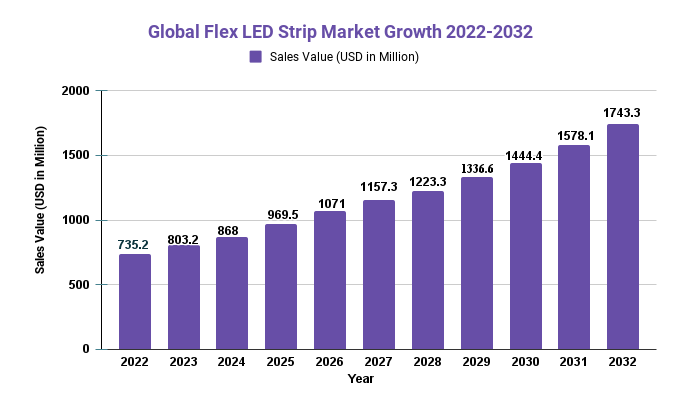Flex LED Strip Market To Develop Strongly And Cross USD 1743.3 Mn By 2032

Page Contents
Market Overview
Published Via 11Press: The Flex LED Strip Market size is expected to be worth around USD 1743.3 Mn by 2032 from USD 735.2 Mn in 2022, growing at a CAGR of 9.3% during the forecast period from 2022 to 2032.
The flex LED strip market has experienced remarkable growth in the last few decades. This is due to the flexibility and versatility of these strips, coupled with their energy efficiency, low heat emission, and long lifespan. The demand for flex LED strips continues to increase across various industries such as entertainment, automotive, residential lighting, and commercial applications.
In the entertainment industry, flex LED strips are used for stage lighting, creating stunning visual effects that captivate audiences. In the automotive industry, they are used for interior lighting in cars to enhance aesthetics and provide better visibility at night. Residential properties use flex LED strips for accent lighting or backlighting artwork and furniture pieces. Commercial spaces use them for signage purposes or decoration.
Growth in the flex LED strip market is expected to continue due to advancements in technology leading to improved quality products that offer more efficient energy consumption and better color rendering index (CRI).
Request For Sample Report Here: https://market.us/report/flex-led-strip-market/request-sample/

Key Takeaways
- Flex LED strips are an incredibly versatile lighting solution, suitable for various uses such as decorative purposes, architectural illumination, or task illumination.
- LED strips are constructed with individual LED lights mounted onto a flexible circuit board, enabling them to be bent, curbed, or shaped to fit almost any surface.
- Flex LED strips come in a range of colors, with RGB strips offering the versatility to produce unique hues by using red, green, and blue LEDs.
- They are often employed in DIY projects due to their ease of use and versatility; they can even be cut to size for specific applications.
- Flex LED strips can be controlled in several ways, including remote controls, smartphone applications, or wall-mounted switches.
- When installing flex LED strips, it's essential to select the appropriate type for the application and guarantee they are installed securely in order to avoid damage or fire hazards.
- They are highly energy-efficient and can last up to 50,000 hours, making them a cost-effective lighting solution for both residential and commercial uses.
Regional Analysis
- North America The flex LED strip market in North America is expected to witness significant growth due to rising demand for energy-efficient lighting solutions and the presence of key market players within the region.
- Europe The flex LED strip market in Europe is expected to experience growth due to the rising adoption of LED lighting solutions and government initiatives promoting energy efficiency.
- Asia-Pacific The flex LED strip market in Asia-Pacific is expected to experience the highest growth rate due to factors such as urbanization, increasing disposable income, and growing awareness about energy-saving lighting solutions.
- Latin America The flex LED strip market in Latin America is expected to expand due to increasing construction activities and government initiatives to promote energy efficiency.
- Middle East & Africa The flex LED strip market in the Middle East and Africa is expected to witness strong growth due to increased infrastructure construction as well as an uptick in energy-saving lighting solutions.
- Overall, the flex LED strip market is expected to expand globally due to growing awareness about energy efficiency and the advantages of LED lighting solutions. However, the growth rates may vary based on factors such as economic conditions, government regulations, and consumer preferences.
Drivers
- Energy-Efficient Lighting Solutions: Flex LED strips are highly energy-efficient and use much less electricity than traditional lighting solutions, increasing the demand for energy-saving lighting solutions like flex LED strips as energy costs continue to rise. Versatility, Flex LED strips have the versatility to be used in a variety of applications, such as decorative lighting, task lighting, and architectural illumination. This versatility has contributed to an increase in demand for these products. Cost Effectiveness, Flex LED strips have become more cost-effective due to advances in technology and decreasing production costs, making them a cost-effective alternative to traditional lighting solutions.
- DIY Trend: The DIY movement has also driven growth in the flex LED strip market, as consumers seek customizable and easy-to-install lighting solutions for their homes and businesses. Long Lifespan, Flex LED strips boast an impressive lifespan, with some models lasting up to 50,000 hours. This makes them a reliable and cost-effective solution for both residential and commercial uses alike. Government Regulations, Governments around the world are enforcing regulations and policies to promote energy efficiency and reduce carbon emissions. This has resulted in an uptick in demand for energy-saving lighting solutions such as flex LED strips.
- Overall, the flex LED strip market is being driven by factors such as energy efficiency, versatility, cost efficiency, and increasing government regulations. These trends are expected to continue fueling growth in this space for years to come.
Browse the summary of the report and Complete Table of Contents (TOC): https://market.us/report/flex-led-strip-market/table-of-content/
Restraints
- High Initial Cost: Although flex LED strips have become cheaper over time, their cost remains higher than other lighting solutions, potentially deterring some consumers from investing in them. Technical Limitations, Flex LED strips have some technical limitations, such as limited brightness and color options, plus the requirement for additional components like controllers and power supplies.
- Lack of Standardization: In the flex LED strip market, there is a lack of standardization which makes it difficult for consumers to compare products and guarantee compatibility between different components. Heat Dissipation Flex LED strips generate heat, which may be an issue in certain applications. If not addressed properly, this heat could damage the LEDs or even pose a fire hazard.
- Limited lifespan of power supplies: While flexing LED strips may have a long life expectancy, the same cannot be said for their power supplies. In some cases, the replacement of these parts may be more frequent than replacing LED strips themselves. Environmental Issues LED lighting solutions like flex LED strips are more energy-efficient than traditional lighting sources, but still contain some hazardous materials which must be disposed of safely to protect the environment.
- Overall, these limitations highlight some of the issues confronting the flex LED strip markets, such as high costs, technical limitations, and environmental concerns. Addressing these issues will be essential in ensuring its continued growth and success going forward.
Opportunities
- Smart lighting: With the advent of smart home technology and the Internet of Things (IoT), there is now a potential for flexible LED strips to be integrated into connected lighting systems. This could include features such as voice control, scheduling, and color-changing capabilities. Commercial Applications Flex LED strips are increasingly being used for commercial purposes, such as retail stores, hotels, and restaurants. This presents manufacturers with an opportunity to develop specialized products specifically tailored for these industries.
- Outdoor Lighting: Flex LED strips can be used for outdoor lighting applications, such as gardens, patios, and decks. As more people look to enhance their outdoor living spaces with lighting solutions like flex LED strips, there is an increasing demand for such solutions. Customization Flex LED strips can be cut to size and shaped to fit specific applications, providing manufacturers with a chance to customize products based on individual customer demands.
- Emerging markets: particularly those in Asia and Africa, present an opportunity for flex LED strip manufacturers to expand their presence and access new customer segments. Energy Efficient Regulations As more countries enforce energy efficiency laws, there is an increasing demand for energy-saving lighting solutions like flex LED strips. This presents manufacturers with an opportunity to develop new products and expand their customer base.
- Overall, the flex LED strip market offers numerous opportunities for growth and innovation, particularly in smart lighting, commercial applications, and outdoor lighting. By capitalizing on these chances, manufacturers can continue to fuel market expansion while meeting customers' evolving needs.
Challenges
- Intense competition: The flex LED strip market is highly competitive, with many manufacturers offering similar products. This can make it difficult for companies to differentiate themselves and maintain market share. Quality control Ensuring consistent quality across different batches of flex LED strips can be a challenge, particularly for manufacturers who source components from different suppliers. Poor quality can lead to issues such as premature failure, which can damage a company's reputation and hurt sales.
- Intellectual property infringement: The flex LED strip market has seen a significant amount of intellectual property infringement, with some manufacturers copying designs and technologies from others. This can lead to legal disputes and damage the reputation of the original innovator. Supply chain disruptions The COVID-19 pandemic highlighted the vulnerability of global supply chains, with disruptions in manufacturing and shipping leading to shortages and price increases for some components. This can impact the availability and cost of flex LED strips.
- Technical complexity: Flex LED strips can be technically complex to design and manufacture, particularly for manufacturers who are new to the market. This can lead to quality issues and delays in product development. Environmental concerns While flex LED strips are more energy-efficient than traditional lighting solutions, they still require resources to manufacture and can contribute to e-waste. Manufacturers must take steps to minimize their environmental impact and ensure proper disposal methods are used.
- Overall, these challenges highlight the importance of quality control, innovation, and sustainability in the flex LED strip market. Addressing these challenges will be key to maintaining growth and meeting the evolving needs of customers.
Report Scope
| Report Attribute | Details |
| The market size value in 2022 | USD 735.2 Mn |
| Revenue forecast by 2032 | USD 1743.3 Mn |
| Growth Rate | CAGR Of 9.3% |
| Regions Covered | North America, Europe, Asia Pacific, Latin America, and Middle East & Africa, and the Rest of the World |
| Historical Years | 2017-2022 |
| Base Year | 2022 |
| Estimated Year | 2023 |
| Short-Term Projection Year | 2028 |
| Long-Term Projected Year | 2032 |
Key Market Segments
Type
- 3528
- 5050
Application
- Low Voltage
- High Voltage
Key Market Players included in the report:
- OML Technology
- Jiasheng Lighting
- Osram
- Philips
- Forge Europa
- Sidon Lighting
- Optek Electronics
- NVC Lighting
- Opple
- Jesco Lighting
- Ledtronics
- PAK
- FSL
Frequently Asked Questions
What is the market study period?
The Flex LED Strip Market is studied from 2017 – 2032.
What is the growth rate for the Flex LED Strip Market?
The Flex LED Strip Market is growing at a CAGR of 9.3%
Who are the major players in the Flex LED Strip Market?
OML Technology, Jiasheng Lighting, Osram, Philips, Forge Europa, Sidon Lighting, Optek Electronics, NVC Lighting, Opple, Jesco Lighting, Ledtronics, PAK, FSL
The team behind market.us, marketresearch.biz, market.biz and more. Our purpose is to keep our customers ahead of the game with regard to the markets. They may fluctuate up or down, but we will help you to stay ahead of the curve in these market fluctuations. Our consistent growth and ability to deliver in-depth analyses and market insight has engaged genuine market players. They have faith in us to offer the data and information they require to make balanced and decisive marketing decisions.



